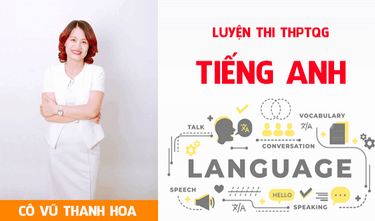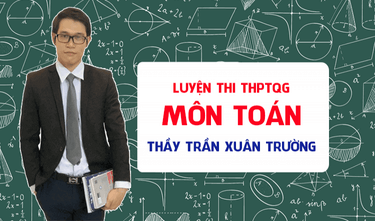600 câu trắc nghiệm Tiếng Anh 12 mới (thí điểm - có đáp án) | Bài tập Tiếng Anh 12 mới
Để học tốt môn Tiếng Anh 12 (chương trình thí điểm), bộ 600 bài tập trắc nghiệm Tiếng Anh lớp 12 chương trình mới gồm đầy đủ các kĩ năng: Phonetics and Speaking, Vocabulary and Grammar, Reading, Writing có đáp án và giải thích chi tiết.
600 câu trắc nghiệm Tiếng Anh 12 mới (có đáp án)
VietJack giới thiệu Bài tập Tiếng Anh 12 mới gồm đầy đủ từ vựng, ngữ pháp, bài tập theo từng unit có lời giải chi tiết:
Chỉ từ 150k mua trọn bộ Bài tập Tiếng Anh 12 bản word có lời giải chi tiết:
- B1: gửi phí vào tk:
0711000255837- NGUYEN THANH TUYEN - Ngân hàng Vietcombank (QR) - B2: Nhắn tin tới Zalo VietJack Official - nhấn vào đây để thông báo và nhận giáo án
Unit 1: Life stories
Unit 2: Urbanisation
Unit 3: The green movement
Unit 4: The mass media
Unit 5: Cultural identity
Unit 6: Endangered species
Unit 7: Artificial intelligence
Unit 8: The world of work
Unit 9: Choosing a career
Unit 10: Lifelong learning
Trắc nghiệm Tiếng Anh 12 mới Unit 1 (có đáp án): Life stories
A. Phonetics and Speaking
Choose the word which is stressed differently from the rest.
Question 1: A. access B. afford C. brochure D. casual
Đáp án: B
Giải thích: Đáp án A, C, D trọng âm 1. Đáp án B trọng âm 2.
Question 2: A. behaviour B. determined C. counselor D. decisive
Đáp án: C
Giải thích: Đáp án A, B, D trọng âm 2. Đáp án C trọng âm 1.
Question 3: A. donate B. compare C. campaign D. flashy
Đáp án: D
Giải thích: Đáp án A, C, B trọng âm 2. Đáp án D trọng âm 1.
Question 4: A. experience B. mobility C. independent D. prioritise
Đáp án: C
Giải thích: Đáp án A, B, D trọng âm 2. Đáp án C trọng âm 3.
Question 5: A. romantic B. solution C. protective D. elegant
Đáp án: D
Giải thích: Đáp án A, C, B trọng âm 2. Đáp án D trọng âm 1.
Question 6: A. legal B. obey C. forbid D. impose
Đáp án: A
Giải thích: Đáp án B, C, D trọng âm 2. Đáp án A trọng âm 1.
Question 7: A. constitution B. disrespectful C. sympathetic D. elongated
Đáp án: D
Giải thích: Đáp án A, C, B trọng âm 3. Đáp án D trọng âm 2.
Question 8: A. generational B. interpersonal C. discrimination D. nationality
Đáp án: C
Giải thích: Đáp án A, B, D trọng âm 3. Đáp án C trọng âm 4.
Question 9: A. studious B. unite C. mature D. involve
Đáp án: A
Giải thích: Đáp án B, C, D trọng âm 2. Đáp án A trọng âm 1.
Question 10: A. frustrating B. charity C. impairment D. infectious
Đáp án: B
Giải thích: Đáp án A, C, D trọng âm 2. Đáp án B trọng âm 1.
Question 11: A. hospital B. mischievous C. supportive D. special
Đáp án: C
Giải thích: Đáp án A, B, D trọng âm 1. Đáp án C trọng âm 2.
Question 12: A. family B. whenever C. obedient D. solution
Đáp án: D
Giải thích: Đáp án A, C, B trọng âm 1. Đáp án D trọng âm 2.
Question 13: A. biologist B. generally C. responsible D. security
Đáp án: B
Giải thích: Đáp án A, C, D trọng âm 2. Đáp án B trọng âm 1.
Question 14: A. confident B. important C. together D. exciting
Đáp án: A
Giải thích: Đáp án B, C, D trọng âm 2. Đáp án A trọng âm 1.
Question 15: A. possible. B. university C. secondary D. suitable
Đáp án: B
Giải thích: Đáp án A, C, D trọng âm 1. Đáp án B trọng âm 3.
B. Vocabulary and Grammar
Bài 1. Mark the letter A, B, C, or D to indicate the correct answer to each of the following questions.
Question 1: I live in a/an ____ with my parents and my elder sister in the coastal area.
A. extended family B. nuclear family
C. extended house D. nuclear house
Đáp án: B
Nuclear family: gia đình hạt nhân (gia đình gồm bố mẹ và các con)
Dịch nghĩa: Tôi sống trong một gia đình hạt nhân với bố mẹ và chị gái tôi ở vùng ven biển.
Question 2: One advantage of living in a/an ____ is to strengthen relationship between young children and adults.
A. nuclear family B. nuclear house
C. extended family D. extended house
Đáp án: C
Extended family: đại gia đình
Dịch nghĩa: Một lợi thế của việc sống trong một / đại gia đình là tăng cường mối quan hệ giữa trẻ nhỏ và người lớn.
Question 3: In my opinion, family members are responsible for ____.
A. the housework B. the chores
C. homework D. A and B
Đáp án: D
Housework = chore: việc nhà
Dịch nghĩa: Theo tôi, các thành viên trong gia đình chịu trách nhiệm việc nhà.
Question 4: My grandpa is the most conservative person in my family. He never ____ about way of life.
A. gives his opinion B. changes his mind
C. gives his view D. keeps in mind
Đáp án: B
Dịch nghĩa: Ông tôi là người bảo thủ nhất trong gia đình tôi. Anh ấy không bao giờ thay đổi suy nghĩ về cách sống.
Question 5: After graduating from university, I want to ____ my father's footsteps.
A. follow in B. succeed in
C. go after D. keep up
Đáp án: A
Dịch nghĩa: Sau khi tốt nghiệp đại học, tôi muốn theo bước chân của cha tôi.
Question 6: In a nuclear family, both mother and father have responsibility for housekeeping and ____.
A. child care B. homework
C. childcare D. generation gap
Đáp án: C
Childcare (n): việc chăm sóc trẻ
Dịch nghĩa: Trong một gia đình hạt nhân, cả mẹ và cha đều có trách nhiệm giữ gìn nhà cửa và chăm sóc con.
Question 7: Four generations living in the same roof will have different ____ of lifestyle.
A. gaps B. rules
C. manners D. viewpoints
Đáp án: D
Dịch nghĩa: Bốn thế hệ sống chung một mái nhà sẽ có quan điểm sống khác nhau.
Bài 2. Mark the letter A, B, C, or D to indicate the correct answer to each of the following questions.
Question 1: All students ____ wear uniforms at school because it is a rule.
A. should B. have to
C. ought to D. must not
Đáp án: B
Dịch nghĩa: Tất cả học sinh phải mặc đồng phục ở trường vì đó là quy định.
Question 2: You ____ finish your homework before you go to bed.
A. must B. have to
C. should D. ought to
Đáp án: A
Dịch nghĩa: Bạn phải hoàn thành bài tập về nhà trước khi đi ngủ.
Question 3: This drink isn't beneficial for health. You ____ drink it too much.
A. should B. ought to not
C. ought not to D. mustn't
Đáp án: C
Dịch nghĩa: Thức uống này không có lợi cho sức khỏe. Bạn không nên uống nó quá nhiều.
Question 4: This warning sign indicates that you ____ step on the grass.
A. shouldn't B. mustn't
C. don't have to D. ought not to
Đáp án: B
Dịch nghĩa: Dấu hiệu cảnh báo này cho thấy rằng bạn không được bước lên cỏ.
Question 5: I think you ____ do exercise regularly in order to keep your body in good shape.
A. must B. should
C. ought to D. Both B and C
Đáp án: D
Dịch nghĩa: Tôi nghĩ bạn nên tập thể dục thường xuyên để giữ cho cơ thể của bạn trong tình trạng tốt.
Question 6: I will lend you some money, but you ____ pay it back to me next week.
A. should B. have to
C. must D. mustn't
Đáp án: C
Dịch nghĩa: Tôi sẽ cho bạn mượn một số tiền, nhưng bạn phải trả lại cho tôi vào tuần tới.
Question 7: Hoa ____ feed the cats because her mother has done it already.
A. has to B. doesn't have to
C. must D. Both A and C
Đáp án: B
Dịch nghĩa: Hoa không phải cho mèo ăn vì mẹ đã làm xong rồi.
Question 8: Those audiences ____ show their tickets before entering the concert hall.
A. have to B. must
C. ought to D. don't have to
Đáp án: A
Dịch nghĩa: Những khán giả đó phải xuất trình vé trước khi vào phòng hòa nhạc.
C. Reading
Bài 1. Read the following passage and mark the letter A, B, C, or D on your answer sheet to indicate the correct answer to each of the questions.
The American type of football was developed in the 19th century from soccer and rugby football. Played by professionals, amateurs, college and high school students, or young children, football in American is one of the most popular sports besides basketball and baseball. It attracts millions of fans each fall and people are very supportive of their favourite teams. The football playing field of today is rectangular in shape and measures 100 yards long and 53.5 yards wide. White lines are painted on the playing field to mark off the distances to the end zone. The games is divided into four quarters, each fifteen minutes long. The first two quarters are known as the first half. There is a rest period between two halves which usually last about fifteen minutes. Each team has eleven players. Each team has offensive players who play when the team has possession of the ball and defensive players who play when the other team has the possession of the ball. Because of the body contact players have during the game, helmets are worn to protect their head and face area, whereas pads are worn to protect the shoulders, arms, and legs. Also, there are officials carrying whistles and flags to make certain that the rules of the game are followed during the game. The football is made of leather and is brown in colour. It is shaped much like an oval and has white rings near each end of the football. These rings help the players see the ball when it is thrown or someone is running with it. The eight stitches on the top of the football help the players to grip the ball when throwing or passing. The most famous game of the year is Super Bowl that is played in January or February. It is televised around the world and is watched by millions of people each year.
Question 1: What do officials do during the game of football?
A. build up excitement among the fans
B. supervise the game
C. take up tickets
D. spectate the game
Đáp án: B
Thông tin: Also, there are officials carrying whistles and flags to make certain that the rules of the game are followed during the game.
Dịch nghĩa: Ngoài ra, có những quan chức mang theo còi và cờ để chắc chắn rằng các quy tắc của trò chơi được tuân theo trong trò chơi.
Question 2: As mentioned in the text, who are the most active when their team has the ball?
A. offensive players B. defensive players
C. the officials D. the fans
Đáp án: A
Thông tin: Each team has offensive players who play when the team has possession of the ball.
Dịch nghĩa: Mỗi đội có những cầu thủ tấn công chơi khi đội đó sở hữu bóng.
Question 3: Playing American football is the most similar to playing
A. rugby football B. basketball
C. baseball D. volleyball
Đáp án: A
Thông tin: Rugby football = American football.
Dịch nghĩa: Bóng bầu dục còn được gọi là bóng đá kiểu Mỹ.
Question 4: What do pads help the players to protect?
A. their legs and arms B. their heads
C. the whole body D. their faces
Đáp án: A
Thông tin: …… whereas pads are worn to protect the shoulders, arms, and legs.
Dịch nghĩa: …… trong khi đó miếng đệm được đeo để bảo vệ vai, cánh tay và chân.
Question 5: When is the most famous football game held annually?
A. in the fall B. January
C. February D. January or February
Đáp án: D
Thông tin: The most famous game of the year is Super Bowl that is played in January or February.
Dịch nghĩa: Trò chơi nổi tiếng nhất trong năm là Super Bowl được chơi vào tháng 1 hoặc tháng 2.
Question 6: Why are there white rings on each end of the football?
A. to mark off the distances to the end zone
B. to help players run
C. to help players score
D. to help players see the ball
Đáp án: D
Thông tin: These rings help the players see the ball when it is thrown or someone is running with it.
Dịch nghĩa: Những chiếc nhẫn này giúp người chơi nhìn thấy quả bóng khi nó bị ném hoặc ai đó đang chạy với nó.
Question 7: The word "grip" in the passage means to
A. avoid something
B. take something away
C. hold something tightly
D. detect something
Đáp án: C
Thông tin: Grip = hold something tightly (giữ một cái gì đó thật chặt)
Question 8: Which is the most popular sport in the US?
A. Rugby football B. Soccer
C. American football D. It's not mentioned
Đáp án: D
Thông tin: football in American is one of the most popular sports besides basketball and baseball. → không đề cập môn thể thao nào được chơi nhiều nhất.
Question 9: How many people watch the match every year?
A. millions B. billions
C. a million D. a billion
Đáp án: A
Thông tin: It is televised around the world and is watched by millions of people each year.
Dịch nghĩa: Nó được truyền hình trên toàn thế giới và được hàng triệu người theo dõi mỗi năm.
Bài 2. Read the following passage and mark the letter A, B, C, or D to indicate the correct answer to each of the questions.
Who talks more - men or women? Most people believe that women talk more. However, linguist Deborah Tannen, who has the studied the communication style of men and women, says that this is a stereotype. According to Tannen, women are more verbal - talk more - in private situations, where they use conversation as the “glue’ to hold relationships together. But, she says, men talk more in public situations, where they use conversation to exchange information and gain status. Tannen points out that we can see these difference even in children. Little girls often play with one ‘best friend’ and their play includes a lot of conversation. Little boys often play games in groups, their play usually involves more doing than talking. In school, girls are often better at verbal skills, while boys are often better at mathematics.
A recent study at Emory University helps to shed light on the roots of this difference. Researchers studied conversation between children aged 3-6 and their parents. They found evidence that parents talk very differently to their sons than they do to their daughters. The startling conclusion was that parents use more language with their girls. Specifically, when parents talk with their daughters, they use more descriptive language and more details. There is also far more talk about emotions, especially with daughters than with sons.
Question 1: Which sentence best expresses the main idea of the first paragraph?
A. Women talk more than men on the whole
B. Women’s talking is a stereotype
C. Women talk more in private, and men talk more in public
D. Little boys and little girls have different ways of playing
Đáp án: C
Thông tin: “women are more verbal - talk more - in private situations .... men talk more in public situations”
Question 2: Which word is similar in meaning to the word “glue” ?
A. games B. sticky substance
C. rope D. means
Đáp án: B
Thông tin: Glue ∼ sticky substance: chất kết dính, keo hồ
Giải thích: Ta có thể đoán được nghĩa của từ “glue” dựa vào cụm từ “hold relationships together”
Question 3: Which of the following phrases best explains the meaning of the word “verbal”?
A. Deriving from verbs
B. Connected with use of spoken language
C. Using very loud noise
D. Being very talkative
Đáp án: B
Giải thích: Verbal ∼ connected with use of spoken language: bằng lời nói
Question 4: The word “they” refers to___________.
A. Situations B. Men
C. Men and women D. Women
Đáp án: B
Thông tin: “But, she says, men talk more in public situations, where they use conversation to exchange information”
Dịch nghĩa: Nhưng bà ấy nói rằng đàn ông nói nhiều hơn trong những tình huống công cộng, nơi mà họ dùng cuộc trò chuyện để trao đổi thông tin.
Question 5: Which sentence best expresses the main idea of the second paragraph?
A. Researchers have studied the conversations of children and their parents.
B. Parents do not talk much about sadness with their sons.
C. Study at Emory University can help to explain the differences between communication styles of boys and girls.
D. An Emory University study found than parents talk more with their daughters than with their sons.
Đáp án: D
Thông tin: “A recent study at Emory University helps to shed light on the roots of this difference... The startling conclusion was that parents use more language with their girls”
Dịch nghĩa: Một nghiên cứu gần đây tại Đại học Emory giúp làm sáng tỏ nguồn gốc của sự khác biệt này ... Kết luận đáng ngạc nhiên là cha mẹ sử dụng nhiều ngôn ngữ hơn với con gái của họ.
Question 6: Which of the following statement is TRUE about the passage?
A. Parents give more love to their daughters than to their sons.
B. Boys don’t like to be with their parents as much as girls do.
C. Parents use more language to talk with their daughters.
D. Boys don’t like showing emotions.
Đáp án: C
Thông tin: “The startling conclusion was that parents use more language with their girls. Specifically, when parents talk with their daughters, they use more descriptive language and more details.”
Dịch nghĩa: Kết luận đáng ngạc nhiên là cha mẹ sử dụng nhiều ngôn ngữ hơn với con gái của họ. Cụ thể, khi cha mẹ nói chuyện với con gái, họ sử dụng ngôn ngữ mô tả nhiều hơn và chi tiết hơn.
D. Writing
Mark the letter A, B, C, or D to indicate the sentence that is closest in meaning to each of the following questions.
Question 1: Nobody in the class is as tall as Mike.
A. Everybody in the class is taller than Mike.
B. Somebody in the class may be shorter than Mike.
C. Mike is the tallest student in the class.
D. Mike may be taller than most students in the class.
Đáp án: C
Dịch nghĩa: Mike là học sinh cao nhất trong lớp.
Question 2: I haven't got enough money to buy a new car.
A. I need more money to buy a new car.
B. I don't want to spend more money on a new car.
C. A new car is not something I really need.
D. Money is not the most essential issue to buy a new car.
Đáp án: A
Dịch nghĩa: Tôi cần nhiều tiền hơn để mua một chiếc xe mới.
Question 3: I am really keen on playing sports.
A. I am a big fan of sports.
B. Playing sports makes me sick.
C. I am not really into sports.
D. I can't stand sports.
Đáp án: A
Dịch nghĩa: Tôi là một fan hâm mộ lớn của thể thao.
Question 4: “I will come back home soon,” he said.
A. He advised to come back home soon.
B. He offered to come back home soon.
C. He promised to come back home soon.
D. He suggested that he should come back home soon.
Đáp án: C
Dịch nghĩa: Anh hứa sẽ sớm trở về nhà.
Question 5: He prevented his close friend from telling the truth.
A. He forbade his close friend to tell the truth.
B. He allowed his close friend to tell the truth.
C. He ordered his close friend to tell the truth.
D. He paid his close friend to tell the truth.
Đáp án: A
Dịch nghĩa: Anh ta cấm người bạn thân của mình nói sự thật.
Question 6: My brother speaks too loud. It is really annoying.
A. My brother is speaking too loud.
B. My brother likes to speak too loud.
C. My brother feels annoyed when he can't speak too loud.
D. My brother is always speaking too loud.
Đáp án: D
Dịch nghĩa: Anh tôi luôn nói quá to.
Question 7: There is always conflict between parents and children. However, they still should talk and share things with each other.
A. Although there is always conflict between parents and children, they still should talk and share things with each other.
B. There is always conflict between parents and children, so they still should talk and share things with each other.
C. Unless there is always conflict between parents and children, they still should talk and share things with each other.
D. Not only there is always conflict between parents and children, but they still should talk and share things with each other.
Đáp án: A
Dịch nghĩa: Mặc dù luôn có xung đột giữa cha mẹ và con cái, họ vẫn nên nói chuyện và chia sẻ mọi thứ với nhau.
Question 8: Your parents will help you with the problem. You should tell them the story.
A. Because your parents will help you with the problem, you should tell them the story.
B. Your parents will help you with the problem since you should tell them the story.
C. If your parents will help you with the problem, you should tell them the story.
D. Your parents will help you with the problem because you should tell them the story.
Đáp án: A
Dịch nghĩa: Bởi vì cha mẹ của bạn sẽ giúp bạn giải quyết vấn đề, bạn nên kể cho họ nghe câu chuyện.
Question 9: Unemployment rate is high. This makes many children move back to their parents' house.
A. Many children move back to their parents' house, which makes high unemployment rate.
B. High unemployment rate forces many children to move back to their parents' house.
C. Moving back to their parents' house suggests that the unemployment rate is high.
D. It is necessary to move back to your parents' house if unemployment rate is high.
Đáp án: B
Dịch nghĩa: Tỷ lệ thất nghiệp cao buộc nhiều đứa trẻ phải quay về nhà của cha mẹ chúng
Question 10: She is an honest person. She is also a very friendly one.
A. She is an honest but friendly person.
B. She is not only an honest but also a very friendly person.
C. Though she is a honest person, she is friendly.
D. Being honest is necessary to become friendly.
Đáp án: B
Dịch nghĩa: Cô ấy không chỉ là một người trung thực mà còn là một người rất thân thiện.
Question 11: The car was very expensive and he couldn’t afford it.
A. The car was very expensive so that he couldn’t buy it.
B. The car was too expensive for him to buy.
C. He was rich enough to buy the car.
D. He was so poor but he bought the car.
Đáp án: B
Thông tin: too adj for somebody to do something : quá để ai làm gì
Dịch nghĩa: Chiếc xe rất đắt và anh ta không thể mua được nó = B. Chiếc xe quá đắt cho anh ta mua.
Question 12: “Please send me to a warm climate” Tom said.
A. Tom pleaded with the boss to send him to a warm climate.
B. Tom begged the boss to send him to a warm climate.
C. Tom would rather went to a warm climate.
D. Tom asked his boss to go to a warm climate.
Đáp án: B
Thông tin: (to) beg someone to do something: cầu xin ai làm gì = (to) plead someone for doing something
Dịch nghĩa: “Làm ơn đưa tôi đến nơi có khí hậu ấm áp.” Tom nói
Question 13: He expected us to offer him the job.
A. We were expected to be offered him the job.
B. He expected to be offered the job.
C. He is expected that we should offer him the job.
D. He was offered the job without expectation.
Đáp án: B
Dịch nghĩa: Anh ta mong chúng tôi sẽ mời ông ta làm việc.
Question 14: He held the rope with one hand. He stretched it out.
A. The robe is held with one hand then he stretched it out.
B. Stretching the robe out, he holds it with one hand.
C. Holding the rope with one hand, he stretched it out.
D. He stretched the rope with one hand and held it.
Đáp án: C
Dịch nghĩa: Anh ta cầm dây thừng bằng một tay. Anh kéo nó ra.
Question 15: The plan may be ingenious. It will never work in practice.
A. Ingenious as it may be, the plan will never work in practice.
B. Ingenious as may the plan, it will never work in practice.
C. The plan may be too ingenious to work in practice.
D. The plan is as impractical as it is genius.
Đáp án: A
Dịch nghĩa: Kế hoạch có thể rất tài tình. Nó sẽ không bao giờ có tác dụng trong thực tiễn.
Cấu trúc: Adj + as/though + S + V, clause: dù.... đến thế nào.
Tài liệu giáo án, đề thi lớp 12 có đáp án hay khác:
Sách VietJack thi THPT quốc gia 2024 cho học sinh 2k6:
Săn shopee siêu SALE :
- Sổ lò xo Art of Nature Thiên Long màu xinh xỉu
- Biti's ra mẫu mới xinh lắm
- Tsubaki 199k/3 chai
- L'Oreal mua 1 tặng 3
- Soạn Văn 12
- Soạn Văn 12 (bản ngắn nhất)
- Văn mẫu lớp 12
- Giải bài tập Toán 12
- Giải BT Toán 12 nâng cao (250 bài)
- Bài tập trắc nghiệm Giải tích 12 (100 đề)
- Bài tập trắc nghiệm Hình học 12 (100 đề)
- Giải bài tập Vật lý 12
- Giải BT Vật Lí 12 nâng cao (360 bài)
- Chuyên đề: Lý thuyết - Bài tập Vật Lý 12 (có đáp án)
- Bài tập trắc nghiệm Vật Lí 12 (70 đề)
- Luyện thi đại học trắc nghiệm môn Lí (18 đề)
- Giải bài tập Hóa học 12
- Giải bài tập Hóa học 12 nâng cao
- Bài tập trắc nghiệm Hóa 12 (80 đề)
- Luyện thi đại học trắc nghiệm môn Hóa (18 đề)
- Giải bài tập Sinh học 12
- Giải bài tập Sinh 12 (ngắn nhất)
- Chuyên đề Sinh học 12
- Đề kiểm tra Sinh 12 (có đáp án)(hay nhất)
- Ôn thi đại học môn Sinh (theo chuyên đề)
- Luyện thi đại học trắc nghiệm môn Sinh (18 đề)
- Giải bài tập Địa Lí 12
- Giải bài tập Địa Lí 12 (ngắn nhất)
- Giải Tập bản đồ và bài tập thực hành Địa Lí 12
- Bài tập trắc nghiệm Địa Lí 12 (70 đề)
- Luyện thi đại học trắc nghiệm môn Địa (20 đề)
- Giải bài tập Tiếng anh 12
- Giải bài tập Tiếng anh 12 thí điểm
- Giải bài tập Lịch sử 12
- Giải tập bản đồ Lịch sử 12
- Bài tập trắc nghiệm Lịch Sử 12
- Luyện thi đại học trắc nghiệm môn Sử (20 đề)
- Giải bài tập Tin học 12
- Giải bài tập GDCD 12
- Giải bài tập GDCD 12 (ngắn nhất)
- Bài tập trắc nghiệm GDCD 12 (37 đề)
- Luyện thi đại học trắc nghiệm môn GDCD (20 đề)
- Giải bài tập Công nghệ 12











